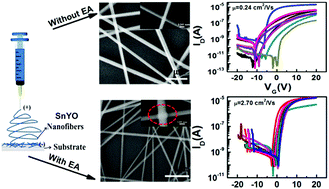Amelioration of interfacial combination and suppression of oxygen vacancies for high performance environmentally friendly electrospun SnYO nanofiber field-effect transistors†
Abstract
One-dimensional semiconductor nanofibers have been regarded as one of the most promising building blocks for next-generation electronic devices. Among these semiconductor nanofibers, tin oxide (SnO2) has been regarded as an attractive alternative for field-effect transistors (FETs) due to its high abundance, nontoxicity and low cost. However, the electronic devices based on electrospun SnO2 nanofibers suffer from poor interfacial property and inferior performance. Here, we have proposed that the introduction of Y can be used to reduce the O vacancies in the channel layers and ethanolamine (EA) is selected as a complexing agent to enhance the interface property. It is confirmed that the SnYO nanofiber FETs based on the addition of EA exhibit better electrical performance, including a mobility of 2.70 cm2 V−1 s−1 and a threshold voltage of 2.3 V. When the high k ZrAlOx films are applied in FETs as dielectric layers, the SnYO nanofiber FETs exhibit optimized electrical performance with an acceptable mobility of 4.78 cm2 V−1 s−1, a small threshold voltage of 0.72 V and a suitable on/off current ratio of ∼107. This work presents a simple and low cost EA treatment method to improve the electrical performance, which provides a new perspective for commercial products based on electrospun nanofibers.



 Please wait while we load your content...
Please wait while we load your content...